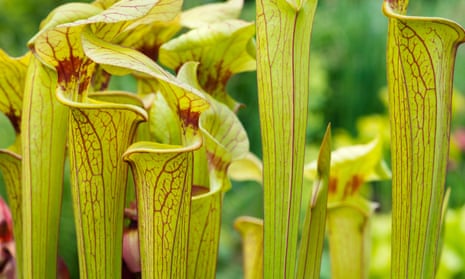I used to be a staunch believer that some plants couldn’t be grown without peat.
I couldn’t see how I could grow Proteas, Banksias and the like unless I used it. Its fibrous, moisture retentive and long lasting nature created just the right environment for their specialised root systems. I grow a lot of peat-loving plants such as Shortias and Vacciniums too. There certainly seemed no way these would grow without the substrate to which they are so inextricably linked in the wild.
But I was wrong.

The last frontiers for peat-free growing are falling. I stopped using peat more than two years ago for my ericaceous plants: their fine moisture-loving roots and obligate link to their fungus partner*, are just as happy in well-rotted leaf mould, fine milled bark, and a helping of ground granite rock dust with occasional feeds of seaweed extract. My blueberry crop last year was better than ever and some of my plants have been putting on three times more growth than before.
It’s not just these Ericaceae either. Another group of plants that have been solely reliant on peat until now are the carnivores; Sarracenia (pitcher plants), Drosera (sundews), Pinguicula (butterworts) and the like: they all need acid, nutrient-poor conditions and are adapted to grow almost exclusively in peat bogs in the wild. Many carnivorous plants are very threatened in their wild state and one of their biggest threats, alongside poaching, is the destruction of their natural habitat for the peat it contains. Is it right, then, that we should destroy peat bogs and the wild plants they contain just so we can grow them in our gardens? I don’t think so.

Luckily, trials are proving that carnivorous plants aren’t so inextricably linked to peat, either. Mike King from Shropshire Sarracenias has come up with a peat free mix for his pitcher plants; it’s so good he doesn’t bother with peat at all for his National Collection now. “One part perlite, one part fine or coarse Cornish grit and two parts fine milled bark from Melcourt” he told me when I asked for his, now not-so-secret, recipe. If someone in his position is saying he can only see advantages with this peat-free mix, then I really hope this will be the start of a revolution for the carnivorous plant growing community.
What is more, Sue and Bleddyn Wynn-Jones of Crûg Farm Plants, where I work as a propagator, have made the bold step this year to go peat-free. One of their biggest stumbling blocks in the move to peat free for their huge variety of species was finding a reliable, and invariable, compost that could be easily supplied in bulk; I am pleased to say that they found one. The plants there seem not to have noticed the change, in fact, I would go so far as to say they are relishing it. The range of botanical wonders at Crûg means that every taste has to be catered for when it comes to the choice of compost, and while a slightly different watering regime is taking time to get used to, the plants are certainly suffering no ill effects.
If companies like Crûg are able to go peat free, then every gardener should be able to do the same. Our peat bogs are so intrinsically important to the future of this planet as carbon stores, flood defences and natural habitat for wildlife that we can no longer look lightly on the use of peat in our gardens. There may always be a minuscule case for the use of peat for the most specialist of species whose very existence, through ex-situ conservation, may rely on it. But if carnivores, Ericaceae and all the plant species grown at nurseries such as Crûg can survive without it, then bedding plants and hardy perennials certainly can too. What of my Proteas and Banksias? Well, I am very proud to say, they are peat free now as well.
Gardeners listen up; when it comes to switching to peat free compost, there are no more excuses.
*in other words, they are mutually dependent on each other
